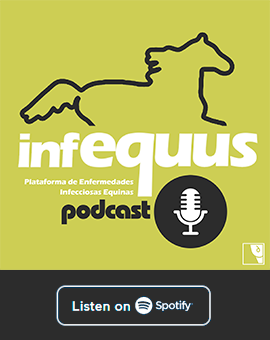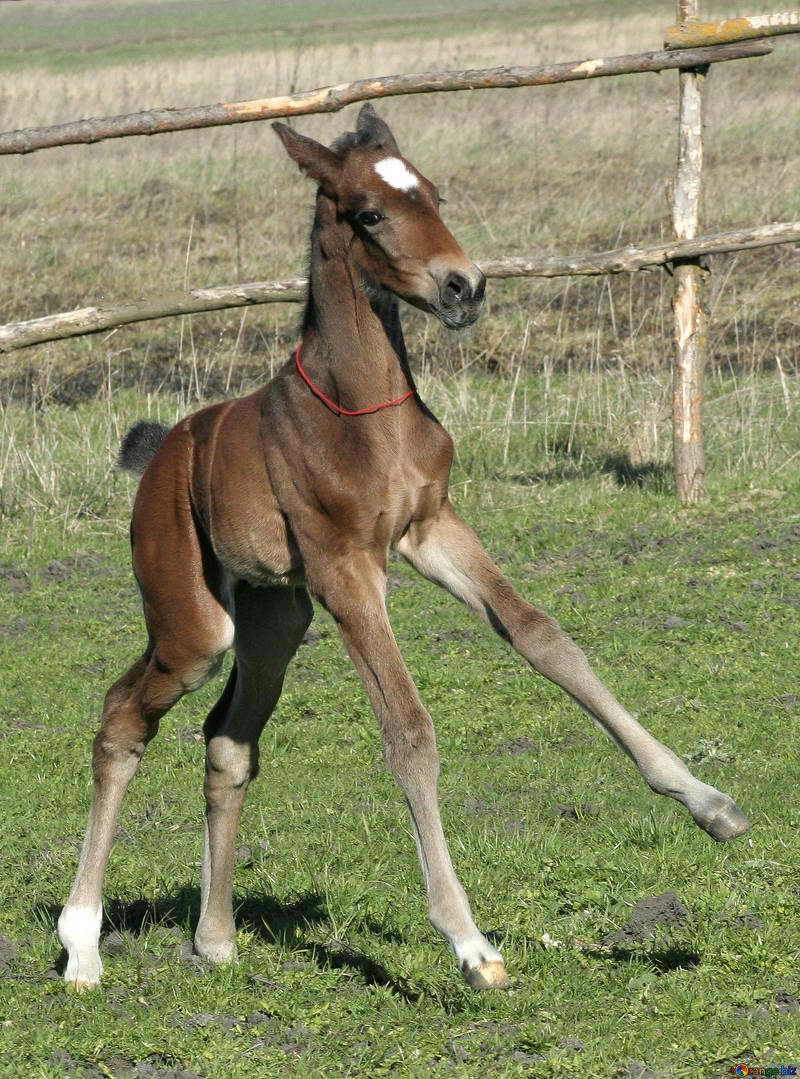Equine proliferative enteropathy
Etiology
Lawsonia intracellularis is an obligate Gram negative intracellular pathogenic bacterium. It is a curved shaped non-flagellated bacillus. It grows preferentially in the cytoplasm of the epithelial cells of the intestine causing the so-called proliferative enteropathy.
Epidemiology
L. intracellularis is a pathogen that affects mainly pigs, causing the proliferative enteropathy, but it can also affect other mammals such as horses, dogs, rats, rabbits, etc. It is worldwide distributed and in recent decades it is considered that equine proliferative enteropathy (EPE) is an emerging disease in horses. The disease usually appears in weaned foals under 12 months of age, although occasionally it can occur in adult horses, being normal that these do not suffer from the disease and act as carriers. The main route of transmission is the faecal-oral route. In contaminated faeces and fomites this microorganism is able to survive at least 14 days at room temperature. The main animal reservoirs for horses seem to be chronic carrier animals, mainly rodents, birds, rabbits and also cats, dogs, etc
Pathogeny
The pathogenesis of EPE is not well known. The disease is characterized by the thickening of the intestinal mucosa caused by a proliferation of enterocytes, although the mechanism by which this is produced is unknown. Once L. intracellularis entries the host it invades the intestinal epithelial cells by a vacuole, multiplies, breaks the cell and disseminates through the cells until they are eliminated and deposited on the intestinal microvilli or between the crypts. The infection extends to the entire intestine, but mainly to the ileum, distal jejunum, caecum and colon, causing hyperplasia of the infected cells, leading to an intensive proliferation process.
The incubation period is from 7 to 14 days. It is usually a self-limiting disease, although it can be chronic.
It seems that factors such as stress, change of diet, weaning, other concomitant diseases, etc. can initiate the development of the EPE.
Clinical signs
The clinical signs and symptoms associated with EPE are highly variable, including fever, anorexia, depression, weight loss, retarded growth, malabsorption, edema in the ventral area, neck or limbs, diarrhea and colic. Sometimes horses are asymptomatic and are considered subclinical carriers. It is characteristic that horses present hypoproteinemia and hypoalbuminemia. Other blood disorders that may occur are anemia, hemoconcentration, leukocytosis or neutropenia.
Diagnosis
Clinically, proliferative enteropathy is difficult to diagnose due to the absence of specific signs or the total absence of them. The appearance of compatible clinical symptoms such as hypoproteinemia, hypoalbuminemia, and thickened areas of the small intestine (determined by ultrasound) may indicate the presence of this pathology. Culture is complicated and cell lines are needed as it is an intracellular microorganism. Microscopic observation can also be carried out by using special stains (Warthin-Starry) in which small curved bacilli are observed within the apical cytoplasm of the enterocytes. The best option is to confirm the presence of L. intracellularis by PCR in intestinal scrapings, biopsy samples or recent faeces. PCR in faeces is useful to confirm when there is suspicion of EPE, but it can be positive in animals that excrete the bacteria but have not developed the disease and can give false negatives when the animal is sick but no longer excretes the microorganism or it is inside the intestinal cells.
Direct methods must be combined with indirect methods, aimed at determining the presence of antibodies in blood. The most serological techniques used are the immunoperoxidase monolayer assay (IPMA), the ELISA, or the indirect immunofluorescence antibody test (IFAT).
The main lesions observed are non-pathognomonic: intestine dilation, haemorrhages, intestinal mucosal hypertrophy with deep transverse grooves, crypt enterocyte hyperplasia with numerous mitosis and absence or reduction of mucus-producing cells. By staining histological sections with silver salts, numerous intracellular microorganisms with a characteristic curved shape can be observed, usually located in the apical cytoplasm of the epithelial cells of the crypt, but this method is not specific for L. intracellularis and does not always detect to the organism in necrotic or autolysate tissue.
Treatment
Animals with mild symptoms can recover without treatment. If signs occur, treatment should be started as soon as possible and include antimicrobial therapy with macrolides such as erythromycin, combined with rifampicin, doxycycline, chloramphenicol or oxytetracycline. In addition, it should be accompanied by supportive therapy with intravenous fluids, plasma transfusions, parenteral nutrition and antiulcer drugs.
Prevention and control
Many aspects of the transmission of L. inracellularis in horses are unknown, so it is difficult to take preventive measures. It seems that rodents and birds can be a source of infection (through their faeces), so the control of these animals can be a preventive measure. Faeces of infected horses must be eliminated and also the animals should be separated from the rest of the herd. Finally, proper biosecurity and hygiene measures must be applied.
There is no authorized vaccine for use in horses, but there is one for pigs that has been used occasionally in this animal species.
Public Health Considerations
EPE It is not a zoonotic disease. There is no need to take any special precautions in relation to Public Health.
References
- https://onlinelibrary.wiley.com/doi/full/10.1111/j.1939-1676.2008.0160.x
- https://www.rossdales.com/assets/files/Lawsonia-intracellularis-infection.pdf
- https://onlinelibrary.wiley.com/doi/epdf/10.1111/evj.12075
- https://ac.els-cdn.com/S0749073914000595/1-s2.0-S0749073914000595-main.pdf?_tid=16c293c4-dd81-4ff4-8b93-dae4319aeddc&acdnat=1536926788_cea166963e77dbe962676454b6f0c957
- https://ac.els-cdn.com/S0378113513003313/1-s2.0-S0378113513003313-main.pdf?_tid=460169fc-10ed-42f1-acb3-d959bc93a3a0&acdnat=1536926170_4b7a0717887db155c26c4ddad983a466
- Equine Infectious Diseases. 2014 Elsevier Inc. ISBN: 978-1-4557-0891-8.


